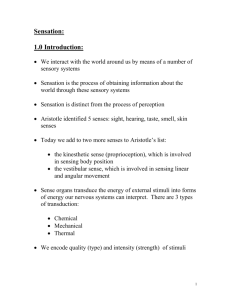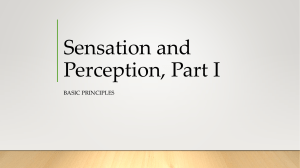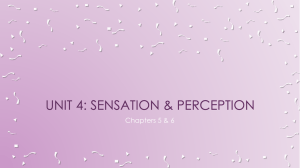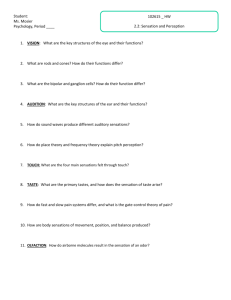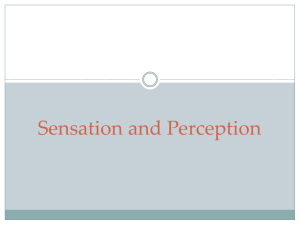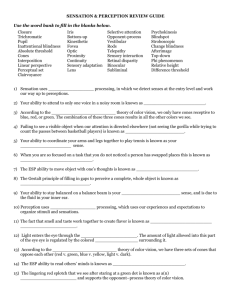Sensation and Eyesight ppt
advertisement
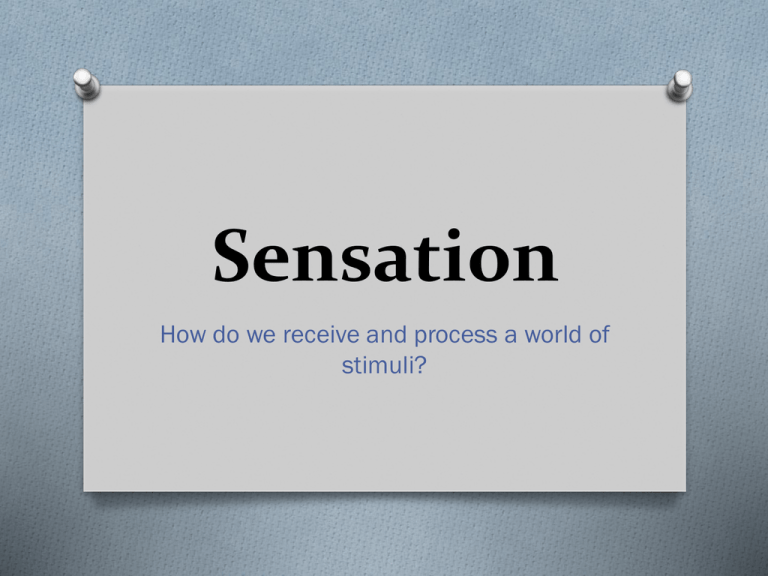
Sensation How do we receive and process a world of stimuli? Goals O Understand what sensation is O Recognize the different levels and abilities of how our senses detect a stimulus O Begin to explore our visual senses Sensation O Process by which we receive, transform and process stimuli that impinge our sensory organs into NI’s, or signals, that the brain uses to create experiences for the five senses O Done through Sensory Receptors: O Special cells that detect stimuli from the outside world (organs of the 5 senses) What do we call the study of sensation? O Psychophysics O Study of how physical sources of stimulation relate to our experience of the stimuli in the form of sensations O How stimuli (light, sound, touch, etc.) effect our sensation and perception Common Characteristics of Function for Sensory Systems O Absolute Threshold O Difference Threshold O Signal Detection O Sensory Adaptation https://www.youtube.com/watch?v=TLV4_ xaYynY Absolute Threshold O Smallest amount of a stimulus that a person can reliably detect O Minimum level of stimulus energy detectable 50% of the time O People have different levels Difference Threshold O A just noticeable difference. How close together can two stimuli be together and still notice a difference. O Weber’s Law O The amount you must change a stimulus to detect a change is given by a constant fraction or proportion of the original stimulus CAN YOU TELL THE DIFFERENCE? CAN YOU TELL THE DIFFERENCE? CAN YOU TELL THE DIFFERENCE? CAN YOU TELL THE DIFFERENCE? CAN YOU TELL THE DIFFERENCE? CAN YOU TELL THE DIFFERENCE? CAN YOU TELL THE DIFFERENCE? CAN YOU TELL THE DIFFERENCE? CAN YOU TELL THE DIFFERENCE? CAN YOU TELL THE DIFFERENCE? Signal Detection O Detection of stimulus depends on; O Intensity of stimulus O Level of background stimulation O Biological and psychological characteristics of the perceiver O The sound difference alone does not determine, the environment plays a very large role O Physical, psychological, background noise https://www.youtube.com/watch?v=ZDwot NLyz10 Sensory Adaptation O Repeated exposure to same stimulus leads to: reduced sensitivity, no change, heightened awareness Vision O You have 5 minutes to fill out the diagram O Use page 215 in your textbook O The process where energy in converted into signals (NI) that the brain interprets to produce the experience of sight Vision O We have vision for up close, staring at your phone, to very far away, the stars billions of miles away. Structures of the eye O Cornea: where light enters, a transparent covering on the eye’s surface O Iris: Muscle that contracts and expands to control amount of light that enters; gives eyes their color O Pupil: black opening inside the Iris where the opening and closing is a reflex O Lens: focuses light rays on the retina O Accommodation: lens changes shape to adjust for distance of the object O Retina: light-sensitive cells (Rods and Cones) in the eye where light is registered Structures Cont. O Rods: measures the intensity of light O There are about 120 million per eye O Cones: registers color O There are about 6 million per eye O Fovea: area near the center of retina that contains only cones and is the center of focus for clearest vision Do you have 20/20 vision? O Nearsighted: unusually close O The eyeball is too long or the Cornea is to curved O Farsighted: unusually far away O Eyeball is to short which throws off the Fovea area How do we see color? O There are two early theories: O Hermann von Helmholtz (1821-1894) O Trichromatic Theory O Ewald Hering (1834-1918) O Opponent-process Theory Trichromatic Theory O Color vision is based on relative activity of 3 types of cones (red, green, and blue-violet) O When green cones are more strongly stimulated we see green, same for red and blue-violet O To see other colors the cones “mix” O Similar to mixing paint O Red + Green cones= Yellow Opponent-process Theory O Experience of color results from opposing processes involving 2 sets of color receptors, red-green and blue-yellow, with another set of opposing receptors, blackwhite, to detect brightness O Red-green cones do not simultaneously transmit images, they transmit messages for one or the other Afterimage • Visual image of a stimulus that remains after the stimulus is Why did that happen? O Disturbed balance of neural activity which the eye attempts to restore by creating an image that is red, white and blue O Red is the afterimage of green O White is the afterimage of black O Blue is the afterimage of yellow So which theory is correct? O Both in a way O Trichromatic: O at the receptor level, some cones are sensitive to only green, red or blue-violet O Opponent-process: O The behavior of cells that lie between the cones and occipital lobe, some are turned on by red or green which inhibits the firing of the other Colorblindness O Trichromats- the three different cones function properly (red, green, blue-yellow) O Monochromats- have only one cone and only see black and white O Dichromats- lack one of the three types of cones O Most common is red-green. About 8% of men and 1% of women

